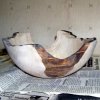Odie
Panning for Montana gold, with Betsy, the mule!
I have a Madrone burl bowl with a large void on the outside of the bowl. This void is about 25 percent of the circumference. The wood takes to tool work nicely, and sanding from about 220gt on up is necessary.
My problem is........I'd like to maintain a nice crisp edge between the void and the tooled surface with no rounding over. The edge between the two surfaces is very irregular, making any use of discs a little too "catchy".
Using hand held sandpaper on the spinning surface won't work. Using a flat sandpaper backer with a single point contact almost works with higher rpm and very light contact.....but, still not good enough.
What I'd like to have is some kind of flexible, but fairly stiff and flat sandpaper backer. It must be flexible while still stiff enough to maintain it's shape for the sanding. That way I can match the profile shape and diameter of the bowl......AND giving me the multiple point contact needed to avoid any rounding over of the edge. What I'm thinking of is something like a flexible lamp neck, only with a flat surface, not round. Any ideas on finding something that would suit this need?
I'm sorry, can't post a photo of the actual bowl at this time......Since my change over of new computer, I am unable to add new photos to my online posts.....only have capability to include previously existing photos.
If worse comes to worse.....I suppose I could completely hand sand the exterior of this bowl......but, if that can be avoided, it would be preferable.
Any ideas out there?
ooc
My problem is........I'd like to maintain a nice crisp edge between the void and the tooled surface with no rounding over. The edge between the two surfaces is very irregular, making any use of discs a little too "catchy".
Using hand held sandpaper on the spinning surface won't work. Using a flat sandpaper backer with a single point contact almost works with higher rpm and very light contact.....but, still not good enough.
What I'd like to have is some kind of flexible, but fairly stiff and flat sandpaper backer. It must be flexible while still stiff enough to maintain it's shape for the sanding. That way I can match the profile shape and diameter of the bowl......AND giving me the multiple point contact needed to avoid any rounding over of the edge. What I'm thinking of is something like a flexible lamp neck, only with a flat surface, not round. Any ideas on finding something that would suit this need?
I'm sorry, can't post a photo of the actual bowl at this time......Since my change over of new computer, I am unable to add new photos to my online posts.....only have capability to include previously existing photos.
If worse comes to worse.....I suppose I could completely hand sand the exterior of this bowl......but, if that can be avoided, it would be preferable.
Any ideas out there?
ooc
Last edited:



